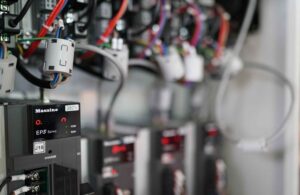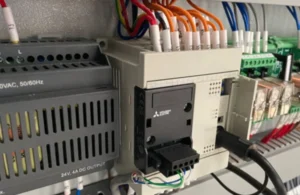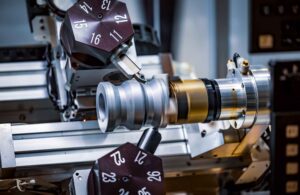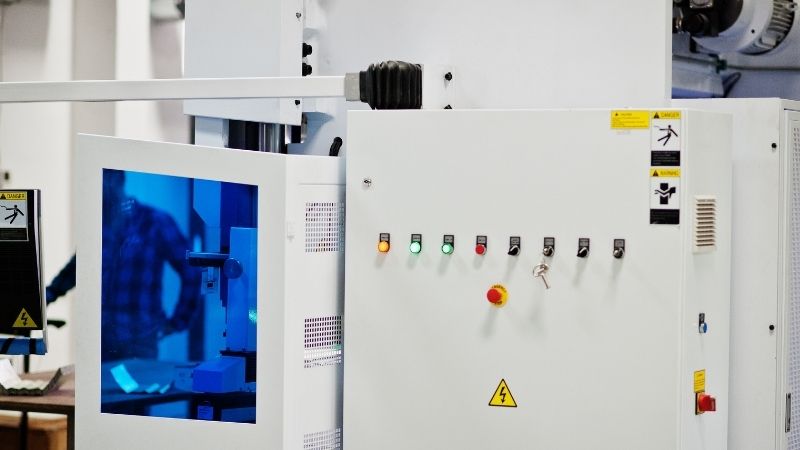RTD ve Termokupllar: Endüstriyel Otomasyon İçin Hayati Sensörler
İster deneyimli bir teknisyen olun, ister bu alanda yeni olun, bu sensörlerin işlevlerini, avantajlarını ve uygulamalarını anlamak, etkili sıcaklık izleme çözümleri uygulama yeteneğinizi artıracaktır.
İçindekiler
RTD Nedir ve Nasıl Çalışır?
Direnç Sıcaklık Dedektörleri (RTD) hassastır sensörler RTD elemanının direncini sıcaklıkla ilişkilendirerek sıcaklığı ölçmek için kullanılır. Genellikle saf platin, nikel veya bakırdan üretilen RTD'ler yüksek doğruluk ve kararlılık sunar ve bu da onları çeşitli endüstriyel uygulamalarda vazgeçilmez kılar.
RTD Sıcaklığı Nasıl Ölçer
RTD, belirli metallerin elektrik direncinin sıcaklıkla öngörülebilir şekilde değiştiği ilkesine dayanarak çalışır. Sıcaklık arttıkça, RTD elemanının direnci de artar. Bu değişim ölçülür ve genellikle bir sıcaklık okumasına dönüştürülür. PLC giriş kartı veya diğer sıcaklık izleme sistemleri.
RTD Yapılandırmalarının Türleri
RTD, farklı kablo yapılandırmalarında gelir: 2 telli, 3 telli ve 4 telli. Her biri, kurşun tel direnci için farklı doğruluk ve telafi seviyeleri sunar. 3 telli RTD, karmaşıklık ve doğruluk arasında iyi bir denge sağladığı için endüstriyel ortamlarda yaygın olarak kullanılır.
Sıcaklık Ölçümünde RTD Termokupllarla Nasıl Karşılaştırılır?
Sıcaklık algılama söz konusu olduğunda, RTD ve termokupllar iki ana yarışmacıdır. Farklılıklarını anlamak, uygulamanız için doğru sensörü seçmenin anahtarıdır.
Doğruluk ve Kararlılık
RTD, termokupllara kıyasla üstün doğrulukları ve uzun vadeli kararlılıklarıyla ünlüdür. Genellikle ±0,1°C'lik bir tolerans sunarlar ve bu da onları hassas sıcaklık kontrolü gerektiren uygulamalar için ideal hale getirir.
Sıcaklık Aralığı
RTD geniş bir sıcaklık aralığı için mükemmel olsa da, termokupllar aşırı yüksek veya düşük sıcaklıkları, genellikle RTD'nin işleyebileceği aralığın ötesinde, ölçmede mükemmeldir. Örneğin, Tip K termokupllar 1.800°C'ye kadar sıcaklıkları ölçebilirken, RTD genellikle yaklaşık 850°C ile sınırlıdır.
Tepki Süresi
Termokupllar, daha basit yapıları nedeniyle genellikle daha hızlı tepki süresine sahiptirler ve bu da onları hızlı sıcaklık değişimlerinin hızla algılanması gereken dinamik prosesler için uygun hale getirir.
RTD Sensörlerinin Toleransını Hangi Faktörler Etkiler?
Bir RTD sensörünün toleransı, sıcaklığı ölçmedeki doğruluğu ve güvenilirliğini ifade eder. Birkaç faktör, bir RTD'nin toleransını etkileyerek hassas sıcaklık izlemeyi garanti edebilir.
Malzeme Kalitesi
RTD elementinin saflığı, genellikle platin, toleransını önemli ölçüde etkiler. Yüksek saflıktaki malzemeler, sıcaklıkla daha öngörülebilir direnç değişiklikleri sergileyerek doğruluğu artırır.
Kalibrasyon
Düzenli kalibrasyon, RTD sensörlerinin zaman içinde doğruluğunu korumasını sağlar. Kalibrasyon, RTD'nin okumalarının bilinen sıcaklık standartlarıyla karşılaştırılmasını ve gerektiği gibi ayarlanmasını içerir.
Çevresel Koşullar
Elektriksel gürültü, titreşimler ve ortam sıcaklığı gibi faktörler RTD performansını etkileyebilir. Uygun koruma ve kurulum uygulamaları bu etkilerin azaltılmasına yardımcı olarak sensörün toleransını korur.
Kabloların RTD Sensör Performansındaki Rolü Nedir?
Bir RTD sensörünün kablolaması, doğru sıcaklık ölçümlerinin sağlanmasında önemli bir rol oynar. Kablo sayısı ve kalitesi, sensörün performansını ve güvenilirliğini etkileyebilir.
Tel Yapılandırması
RTD'ler 2 kablolu, 3 kablolu ve 4 kablolu konfigürasyonlarda mevcuttur:
- 2-Kablolu RTD'ler en basit olanlardır ancak giriş teli direnci nedeniyle hatalara daha açıktırlar.
- 3-Kablolu RTD, kablo direnci için daha iyi bir telafi sunarak gelişmiş doğruluk sağlar.
- 4-Kablolu RTD, ölçümden kablo direncini tamamen ortadan kaldırarak en yüksek doğruluğu sağlar.
Tel Malzemesi ve Kalitesi
Yüksek kaliteli platin tellerin kullanılması, sıcaklık değişimleriyle ilgisi olmayan minimum direnç değişikliklerini garanti eder. Ek olarak, tellerin uygun şekilde korunması, elektriksel gürültünün sensörün okumalarını etkilemesini önleyebilir.
Kurulum Uygulamaları
Termal kuyuların kullanımı da dahil olmak üzere uygun kurulum, RTD sensörünü çevresel faktörlerden ve mekanik stresten koruyabilir, kablo bağlantılarının bütünlüğünü ve genel sensör performansını koruyabilir.
Endüstriyel Otomasyonda PLC'ler RTD Sensörlerle Nasıl Entegre Olur?
Programlanabilir Mantık Denetleyicileri (PLC'ler) modern endüstriyel otomasyon sistemlerinin ayrılmaz bir parçasıdır ve RTD sensörleriyle kusursuz entegrasyonları, etkili sıcaklık izleme ve kontrolü için olmazsa olmazdır.
RTD'leri PLC'lere bağlama
RTD sensörleri, RTD'nin direnç değişimlerini anlamlı sıcaklık verilerine yorumlamak üzere tasarlanmış giriş kartları aracılığıyla PLC'lere bağlanır. Bu giriş modülleri, sıcaklık ölçümlerinin sürekli doğasını ele almak için genellikle analog giriş yeteneklerine sahiptir.
Veri İşleme ve Kontrolü
Bağlandıktan sonra PLC, gerçek zamanlı kararlar almak için sıcaklık verilerini işler. Örneğin, sıcaklık belirli bir ayar noktasını aşarsa PLC, soğutma sistemlerini etkinleştirme veya optimum koşulları korumak için motor hızlarını ayarlama gibi eylemleri tetikleyebilir.
Sistem Güvenilirliğini Artırma
RTD'yi PLC ile entegre etmek, karmaşık izleme ve kontrol stratejilerine olanak tanır ve endüstriyel süreçlerin genel güvenilirliğini ve verimliliğini artırır. Ek olarak, PLC'ler kalibrasyon amaçları ve öngörücü bakım için sıcaklık verilerini kaydedebilir, böylece duruş süresini ve operasyonel maliyetleri azaltır.
Sıkça Sorulan Sorular
RTD'nin termokupllara göre başlıca avantajı nedir?
RTD'ler, termokupllara kıyasla daha yüksek doğruluk ve daha iyi uzun vadeli kararlılık sunar ve bu da onları hassas sıcaklık ölçümleri gerektiren uygulamalar için ideal hale getirir.
Kablo konfigürasyonu RTD performansını nasıl etkiler?
Kablo yapılandırması (2-kablolu, 3-kablolu veya 4-kablolu), kablo direncini telafi ederek sıcaklık okumalarının doğruluğunu etkiler. Daha fazla kablo genellikle daha iyi doğruluk sağlar.
RTD'ler termokupllar gibi aşırı yüksek sıcaklıkları ölçebilir mi?
RTD'ler, termokupllara kıyasla daha sınırlı bir sıcaklık aralığına sahiptir. Çoğu endüstriyel uygulama için uygun olsalar da, termokupllar çok yüksek veya düşük sıcaklıkları ölçmek için tercih edilir.
RTD sensörleri ne sıklıkla kalibre edilmelidir?
Doğruluğun korunması için düzenli kalibrasyon önerilir; genellikle yılda bir kez veya üretici veya endüstri standartlarında belirtildiği şekilde.
Projelerinize yepyeni, orijinal Omron, Mitsubishi, Schneider PLC'lerle güç katın - stokta, hemen kullanıma hazır!
Çözüm
- RTD'ler hassas endüstriyel uygulamalar için ideal, son derece hassas ve kararlı sıcaklık sensörleridir.
- Termokupllar daha geniş bir sıcaklık aralığı ve daha hızlı tepki süreleri sunar ancak RTD'lere göre daha az doğrudur.
- Kablo konfigürasyonu (2-telli, 3-telli, 4-telli) RTD ölçümlerinin doğruluğunda önemli rol oynar.
- PLC'ler RTD sensörleriyle kusursuz bir şekilde entegre olarak otomasyon sistemlerinde gelişmiş sıcaklık izleme ve kontrolüne olanak sağlar.
- RTD sensörlerinin doğruluğunu ve güvenilirliğini korumak için düzenli kalibrasyon ve uygun kurulum uygulamaları esastır.
Endüstriyel otomasyon sektöründeki profesyoneller, RTD'lerin ve termokuplların işlevlerini ve uygulamalarını anlayarak, sıcaklık izleme sistemlerini geliştirmek, operasyonlarında verimlilik ve güvenilirlik sağlamak için bilinçli kararlar alabilirler.
Projeleriniz için yeni, orijinal PLC'ler mi arıyorsunuz? Kwoco'da, en iyi markaların en son PLC'lerini stoklarız: Omron, Mitsubishi, Ve Schneider. Güvenle alışveriş yapın—hızlı kargo, garantili kalite! Hemen Satın Al
Bize Ulaşın
Bu forma adınızı, e-posta adresinizi ve sorunuzun kısa bir açıklamasını girmeniz yeterlidir. 24 saat içinde sizinle iletişime geçeceğiz.
Bu Konuları da İlginizi Çekebilir

SLC500 ve ControlLogix PLC'lerde Ustalaşma: Kapsamlı Bir Kılavuz
Endüstriyel otomasyon, üretimi devrim niteliğinde değiştirmiştir ve bu devrimin kalbinde Programlanabilir Mantık Denetleyicileri (PLC'ler) yer almaktadır. En öne çıkanlar arasında Rockwell Automation'ın SLC 500 ve ControlLogix serileri yer almaktadır. Bu kapsamlı kılavuz, bu denetleyicileri derinlemesine inceleyecek, özelliklerini, uygulamalarını ve otomasyon süreçlerinizi nasıl geliştirebileceklerini anlamanıza yardımcı olacaktır.

En Popüler 7 PLC Markası
En Popüler 7 PLC Markası Mevcut birçok seçenek arasından doğru PLC markasını seçmek bunaltıcı olabilir.

CNC Spindle Motorlarını Anlamak: Eksiksiz Bir Kılavuz
CNC mil motorları, modern üretimde hassasiyet ve verimlilik sağlayan CNC makinelerinin kalbidir. İster deneyimli bir makine operatörü olun, ister bu makinelerin nasıl çalıştığına meraklı olun, bu kapsamlı kılavuz, CNC teknolojisinde mil motorlarının kritik rolüne ışık tutacaktır.






